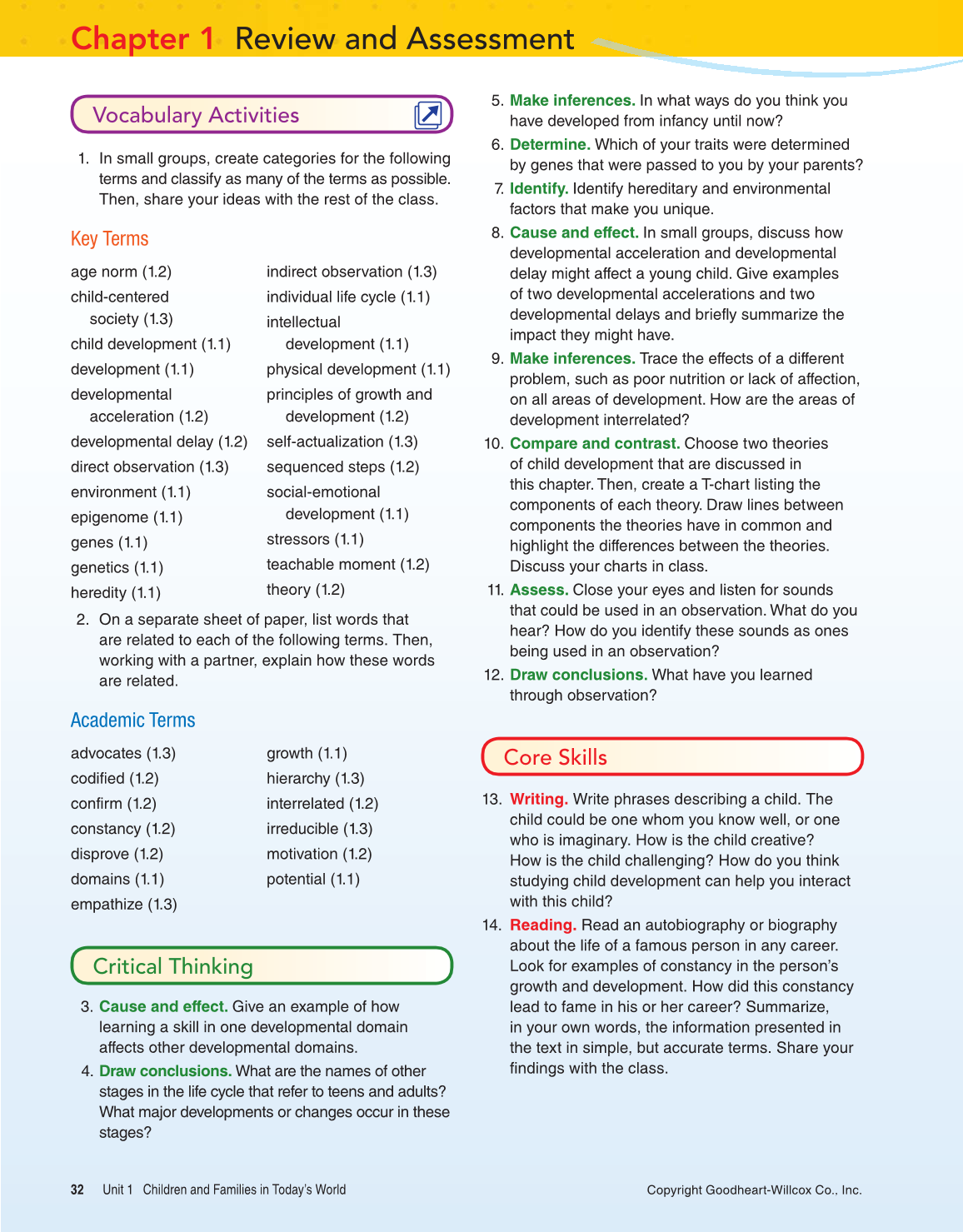32 Unit 1 Children and Families in Today’s World
Copyright Goodheart-Willcox Co., Inc.
Chapter 1 Review and Assessment
Vocabulary Activities
1. In small groups, create categories for the following
terms and classify as many of the terms as possible.
Then, share your ideas with the rest of the class.
Key Terms
age norm (1.2)
child-centered
society (1.3)
child development (1.1)
development (1.1)
developmental
acceleration (1.2)
developmental delay (1.2)
direct observation (1.3)
environment (1.1)
epigenome (1.1)
genes (1.1)
genetics (1.1)
heredity (1.1)
indirect observation (1.3)
individual life cycle (1.1)
intellectual
development (1.1)
physical development (1.1)
principles of growth and
development (1.2)
self-actualization (1.3)
sequenced steps (1.2)
social-emotional
development (1.1)
stressors (1.1)
teachable moment (1.2)
theory (1.2)
2. On a separate sheet of paper, list words that
are related to each of the following terms. Then,
working with a partner, explain how these words
are related.
Academic Terms
advocates (1.3)
codified (1.2)
confirm (1.2)
constancy (1.2)
disprove (1.2)
domains (1.1)
empathize (1.3)
growth (1.1)
hierarchy (1.3)
interrelated (1.2)
irreducible (1.3)
motivation (1.2)
potential (1.1)
Critical Thinking
3. Cause and effect. Give an example of how
learning a skill in one developmental domain
affects other developmental domains.
4. Draw conclusions. What are the names of other
stages in the life cycle that refer to teens and adults?
What major developments or changes occur in these
stages?
5. Make inferences. In what ways do you think you
have developed from infancy until now?
6. Determine. Which of your traits were determined
by genes that were passed to you by your parents?
7. Identify. Identify hereditary and environmental
factors that make you unique.
8. Cause and effect. In small groups, discuss how
developmental acceleration and developmental
delay might affect a young child. Give examples
of two developmental accelerations and two
developmental delays and briefly summarize the
impact they might have.
9. Make inferences. Trace the effects of a different
problem, such as poor nutrition or lack of affection,
on all areas of development. How are the areas of
development interrelated?
10. Compare and contrast. Choose two theories
of child development that are discussed in
this chapter. Then, create a T-chart listing the
components of each theory. Draw lines between
components the theories have in common and
highlight the differences between the theories.
Discuss your charts in class.
11. Assess. Close your eyes and listen for sounds
that could be used in an observation. What do you
hear? How do you identify these sounds as ones
being used in an observation?
12. Draw conclusions. What have you learned
through observation?
Core Skills
13. Writing. Write phrases describing a child. The
child could be one whom you know well, or one
who is imaginary. How is the child creative?
How is the child challenging? How do you think
studying child development can help you interact
with this child?
14. Reading. Read an autobiography or biography
about the life of a famous person in any career.
Look for examples of constancy in the person’s
growth and development. How did this constancy
lead to fame in his or her career? Summarize,
in your own words, the information presented in
the text in simple, but accurate terms. Share your
fi ndings with the class.
